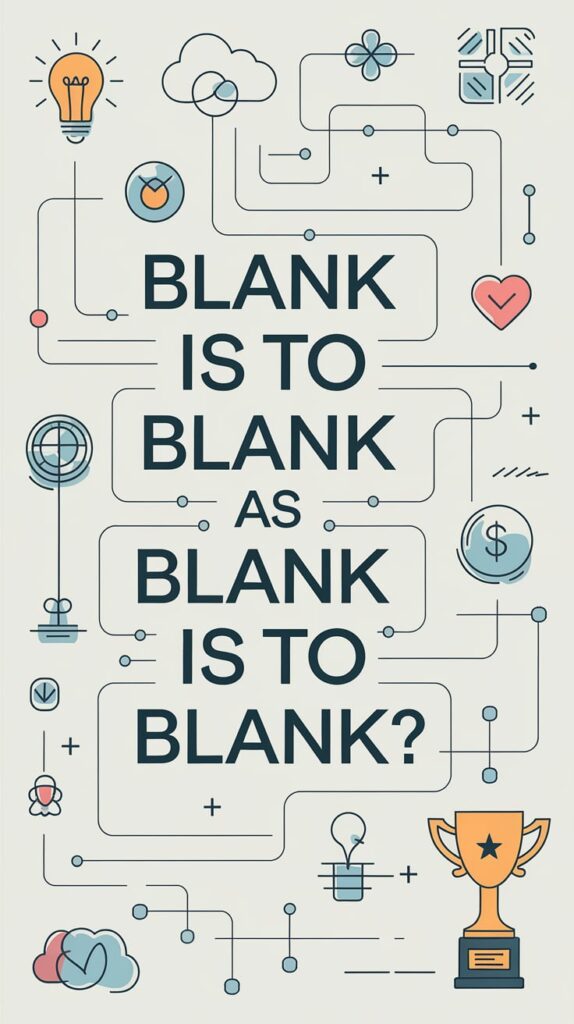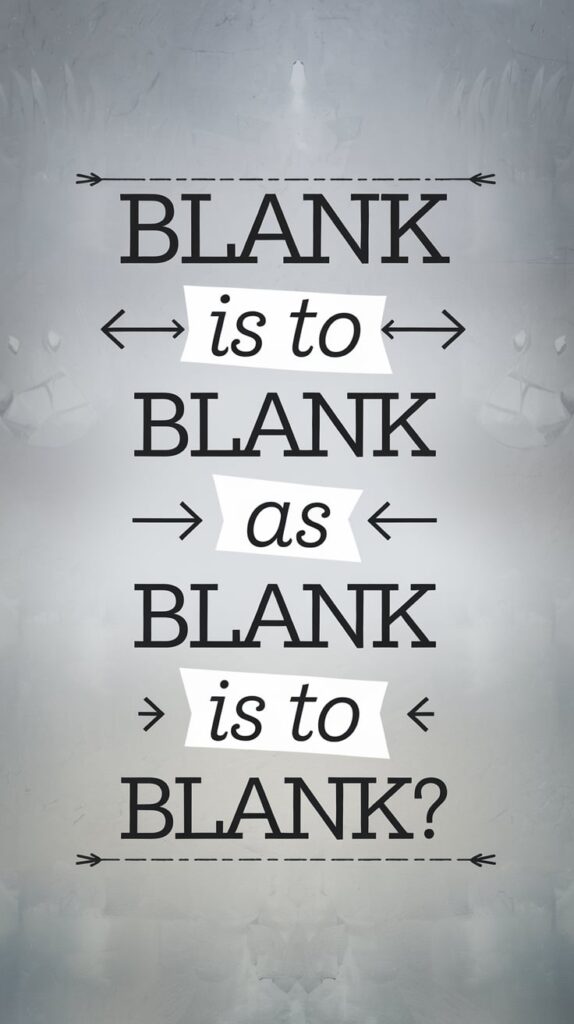Analogies like “Blank Is to Blank as Blank Is to Blank” are powerful tools that make confusing ideas crystal clear. This analogy format helps connect two sets of related concepts, making learning easier, explanations smoother, and communication more engaging.
Whether you’re teaching, presenting, or solving problems, mastering this analogy structure strengthens your thinking and enhances how effectively you convey ideas.
like more : Since vs Sense: Understanding When to Use Each Word – Grammar Beacon
What Does “Blank Is to Blank as Blank Is to Blank” Mean?
To unpack the meaning of “Blank Is to Blank as Blank Is to Blank,” we need to recognize its function as an analogy. Essentially, it highlights the relationships between pairs of concepts.
For instance, consider the analogy “A pen is to writing as a paintbrush is to painting.” Each part of this analogy elucidates how the concepts interrelate, allowing for greater comprehension.
This structure is not merely a linguistic exercise; it serves as a cognitive bridge, helping us make connections and enhance our understanding of complex subjects.

Where Do We Use “Blank Is to Blank as Blank Is to Blank”?
In Educational Settings
Using the phrase in educational environments is especially effective for several reasons:
Teaching Strategies: Educators leverage this analogy to simplify intricate subjects, making them more accessible to students. For example, by comparing mathematical operations to everyday activities, teachers can demystify math concepts.
Curriculum Examples: In science, an analogy such as “Photosynthesis is to plants as digestion is to animals” makes the process relatable. This helps students grasp difficult ideas by relating them to familiar processes.
like more: the Past Tense of See :Saw and Seen – Grammar Beacon
In Troubleshooting
In troubleshooting contexts, the phrase serves as a valuable guide by relating known issues to unfamiliar ones:
Problem-Solving Framework: Analogies help individuals recognize patterns and apply solutions. For example, “A thermostat is to heating as a steering wheel is to driving.
” This analogy aids in understanding the function and importance of control mechanisms in both scenarios.
Application: When diagnosing technical issues, one might use the analogy “Fixing a computer is to an IT technician as solving a mystery is to a detective.
” This structure highlights the analytical thinking required in both professions, promoting a deeper understanding of each role.
In Communication and Persuasion
Using following sentence enhances communication in the following ways:
Clarity and Impact: The phrase improves the clarity of discussions, making ideas more relatable and impactful. For example, “Love is to life as water is to a plant” conveys the necessity of love in a vivid manner.
Persuasive Techniques: Marketers and public speakers often employ analogies to evoke emotional responses. For instance, “A bridge is to a community as a handshake is to friendship.
” This analogy emphasizes connection and relationship-building.
Why Do We Use This Phrase?
Developing Critical Thinking Utilizing using fosters critical thinking by:
Enhancing Analytical Skills: Engaging with analogies encourages individuals to analyze and evaluate ideas critically. This cognitive engagement allows for deeper insights into the material.
Promoting Engagement: When individuals encounter analogies, they are prompted to think more critically about the concepts presented, enhancing their overall understanding.

Learning Facilitation
The phrase is instrumental in facilitating learning because:
Simplicity: Analogies simplify complex ideas, making them more digestible for learners. For instance, “Just as a caterpillar transforms into a butterfly, so does knowledge evolve into wisdom.” This comparison makes abstract concepts more relatable.
Creating Connections: By using analogies, educators can link new information to prior knowledge, enhancing retention and comprehension.
Effective Communication
In the realm of communication:
Ensuring Clear Messaging: This structure ensures that ideas are conveyed clearly and understandably. For example, “A book is to a reader as a map is to a traveler.” This analogy clarifies the purpose of both items.
Fostering Cohesion: Analogies help connect various ideas within a narrative, enhancing the overall flow and coherence of communication.
like more : The Past Tense of Meet – Grammar Beacon
Advantages of Using This Phrase
Better Understanding
One of the primary benefits of using the following:
Relatability: By making comparisons, individuals can relate new information to their existing knowledge, leading to deeper understanding.
Memory Retention: Analogies create mental hooks, anchoring new concepts in familiar contexts. For example, “A teacher is to students as a gardener is to plants” aids in remembering the nurturing role of educators.
Memory Retention
Analogies serve as effective tools for memory retention because they:
Act as Mnemonic Devices: They create vivid associations that aid recall. For instance, “A needle is to sewing as a key is to a lock.” This analogy helps individuals remember the specific functions of each item.
Facilitate Visualization: Many people find it easier to remember information when they can visualize an analogy, which further enhances retention.
In What Situations Should We Use This Phrase?
Educational Settings
In educational contexts :
Instructional Techniques: Teachers can use analogies to clarify complex subjects, leading to enhanced understanding and engagement. For example, “Electricity is to a circuit as water is to a pipe.”
Fostering Engagement: Utilizing relatable examples encourages student participation and interest in the material.
Troubleshooting
When troubleshooting, this phrase proves advantageous by:
Servings as a Diagnostic Tool: It aids in diagnosing problems effectively. For example, “A detective piecing together clues is to solving a case as a scientist analyzing data is to making a discovery.” This analogy clarifies the investigative processes in both fields.
Providing Contextual Examples: Analogies help explain complex troubleshooting methods in simple terms.
Communication and Persuasion
In the realms of communication and persuasion, using “Blank Is to Blank enhances:
Influence: Analogies can serve as persuasive tools, helping to influence decisions and opinions. For example, “A mentor is to a student as a lighthouse is to a ship.” This analogy highlights the guidance and direction provided by mentors.
Clarifying Ideas: When communicating complex ideas, using analogies can make the message clearer and more engaging.

The Origins
Historical Context
To fully appreciate the phrase, it’s essential to understand its historical background:
Ancient Cultures: Many ancient societies used analogical reasoning for teaching and storytelling. This method enabled them to convey complex ideas in a way that was accessible and engaging.
Philosophical Foundations: Greek philosophers, including Aristotle, emphasized the significance of analogies in their discussions. They believed that analogies helped clarify thoughts and foster deeper understanding.
Why People Use This Phrase
The phrase is used frequently because:
Promoting Engagement: This structure encourages listeners to think critically about the material, fostering a richer learning environment.
Simplifying Communication: It transforms complex ideas into simpler concepts that a wider audience can understand.
Enhancing Learning and Communication
Promoting Academic Engagement
Using this analogy in academic settings encourages:
Active Participation: Analogies prompt students to engage actively with the material, enhancing their learning experience. For instance, “An architect is to a building as a composer is to a symphony.”
Facilitating Group Discussions: Incorporating analogies in peer discussions fosters collaboration and deeper understanding among students.
Learning Facilitation
Analogies significantly enhance learning by:
Catering to Different Learning Styles: They benefit auditory, visual, and kinesthetic learners by presenting information in various formats. For example, “A computer is to technology as a canvas is to art.”
Clarifying Concepts: Analogies provide clear, relatable comparisons that help learners grasp new ideas more easily.
Encouraging Critical Thinking
Educators can promote critical thinking by:
Encouraging Deep Analysis: Comparing concepts fosters analytical thinking, leading to more meaningful learning experiences. For example, “An orchestra is to music as a team is to a game,” highlights the importance of collaboration.
Inviting Discussion: Analogies invite students to discuss the implications and relationships of the concepts involved.
Simplifying Complex Ideas
Analogies break down barriers by:
Making Difficult Subjects Approachable: They simplify complex ideas, allowing learners to grasp concepts more easily. For example, “A conductor is to an orchestra as a director is to a film.”
Illustrating Relationships: Using relatable analogies helps clarify relationships between abstract concepts.
Enhancing Communication
Using fosters clearer dialogue by:
Creating Meaningful Connections: Analogies help connect abstract concepts to everyday experiences, enhancing communication. For example, “A friendship is to life as a roadmap is to a journey.”
Improving Engagement: By making ideas relatable, analogies capture the audience’s attention and promote deeper understanding.
Conclusion
Using the “Blank Is to Blank as Blank Is to Blank” analogy empowers you to break down complex subjects, improve communication, and make ideas relatable. By integrating these structured comparisons into conversations, teaching, and problem-solving, you create clarity and connection.
Embrace this analogy format, and you’ll elevate your communication, deepen understanding, and transform the way you think and explain.
FAQs
What does “Blank Is to Blank as Blank Is to Blank” mean?
It is an analogy structure that compares two relationships, helping clarify how two concepts relate to another pair of concepts.
Where is this analogy commonly used?
It’s widely used in education, communication, problem-solving, and persuasive writing to simplify complex ideas.
Why is this analogy helpful in learning?
It creates connections between new information and familiar concepts, improving understanding and memory.
Can this analogy be used in daily communication?
Yes. Using analogies makes explanations clearer and helps audiences grasp ideas quickly.
What is an example of this analogy format?
“A pen is to writing as a paintbrush is to painting.” This shows how each tool relates to its purpose.
How does it enhance critical thinking?
It encourages you to analyze relationships between concepts, boosting reasoning skills and cognitive clarity.
Is this analogy useful in troubleshooting?
Absolutely. It helps relate new problems to familiar patterns, aiding faster diagnosis and solution finding.

James Logan is a seasoned blogger and language enthusiast behind Grammar Beacon. With years of experience in grammar and writing, James shares his expertise through insightful and engaging content. His passion for clear communication and linguistic precision shines in every post, making complex grammar concepts accessible and enjoyable for readers. Follow James for expert advice and tips to refine your writing skills.







